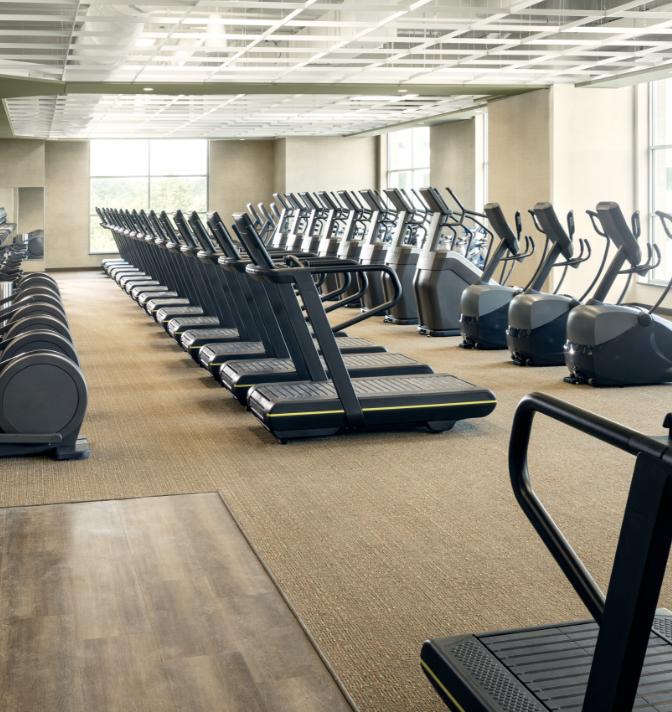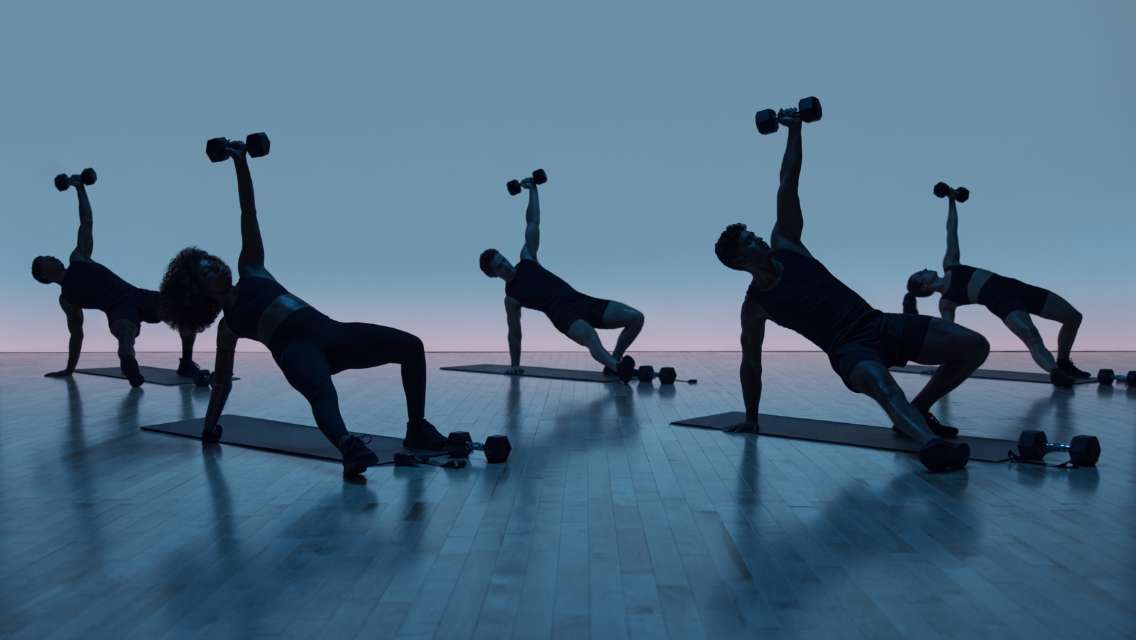For many of us, our active endeavors in the outdoors have a prime season — summer! — and when that time of year gives way to fall and eventually winter, it can seem as though the door is shut on those activities too. But that doesn’t have to be the case.
There are many ways to continue the activities we love during the cooler/colder months — the how and where may just look a little different. “When you’re taking an outdoor activity in, the objective is to closely mimic the movement patterns and challenge yourself even more if there isn’t a one-to-one translation,” says Trapper Steinle, Dynamic Personal Trainer, personal training leader, and metabolic technician at Life Time in Parker, Colo.
Steinle and other Life Time experts share guidance for how to transition some popular summertime activities to the indoors.
If you like swimming in lakes or the ocean, try swimming in an indoor pool.
One benefit of swimming in an indoor pool versus an open body of water is that you’re better able to work on stroke and breathing techniques, says Trisha Stavinoha, Life Time Masters Swim coach in San Antonio, Texas.
“In the pool, you can focus on stroke count, distance per stroke, and pace, without the external distractions of swimming outdoors in open water,” she explains. “Technique is so important. Poor swim technique — like crossing over your arms, dropping your elbow, or lifting your head too high to breathe, for example — can create overuse and shoulder injuries. Swimming indoors offers an environment where you can fine tune your stroke and swim longer distances. Plus, there are other advantages, like you can have your water bottle on the pool deck to stay hydrated during your workout.”
Start by: Figuring out the length of the pool so you know the length of your down-and-back distance. Then, you can pick the distance you want to swim. For example, if you want to swim one mile, that’s 32 laps in a 25-meter pool or 35 laps in a 25-yard pool.
Stavinoha suggests breaking up your mile into shorter intervals and, if you can, having a swim coach watch you to provide feedback. This allows you the opportunity to focus on one skill or technique to improve on. Common errors to look for include dropping your arm when you breathe, breathing only to one side, or taking too many strokes.
If you’re hoping to increase speed, Stavinoha suggests counting your strokes per length and trying to take off one or two strokes per lap. “You’ll be surprised how your speed will naturally improve by simply gliding more,” she says.
If you like cycling on the road or trails, try an indoor cycle class.
Supplementing outdoor training rides with indoor cycling can be an effective method for improving your fitness and cycling technique year-round. You can also train indoors to help prepare for future race seasons.
“There are many benefits to riding indoors,” says Emily Booth, master instructor for indoor cycle in large group training at Life Time in Westminster, Colo. “The room is weatherproofed, there’s the safety of not cycling on the road, and it’s time-efficient because the entirety of class is focused on training — there isn’t added time spent coasting down a hill or stopped at a crosswalk, for example.
“Many cyclists use indoor workouts to enhance specific abilities,” Booth adds. “This could include pedaling technique, benchmark testing, and targeting specific intensity ranges.”
Start by: Exploring your indoor options. Life Time offers a variety of cycle classes and instructors: AMP cycle is a dance-club-style workout featuring choreographed upper-body movements, while EDG cycle and PWR cycle are tailored toward cycle-specific performance enhancement. You could also try one of these indoor cycle workouts:
If you like hiking, try using an inclined treadmill or the stepmill.
Hikers can walk on a treadmill at a steep incline to replicate that movement of being on a trail. Steinle recommends this “because you can control the input, speed, and incline, which allows you to be dedicated with your output. You also don’t have to battle varying terrain.”
One thing to be careful of, he cautions, is not putting all your weight on the handlebars. “If the speed or incline is too difficult, adjust it so you can perform this exercise without leaning on the machine for assistance.”
Steinle also recommends the stepmill and SKILLMILL machines. “The stepmill allows you to develop strength in your legs,” he says. “I’d even suggest skipping a stair to get a deeper knee flexion, which challenges your body more. I’d advise utilizing the SkillMill at a negative three-percent incline. Most people don’t practice deceleration, which is needed for hiking downhill.”
Start by: Trying one of these workouts, suggested by Steinle, if you’re new to training on a treadmill or stepmill:
On the treadmill:
- Start at a walking pace of 3.0 mph and a 1-percent incline.
- Increase your incline by 2 percent every two minutes with the objective of getting to a 15-percent incline.
- Take notice of the point where you can no longer keep up with the speed of the belt or you feel the need to hold on to the treadmill.
⋅ If you reach a 15-percent incline at 3.0 mph and still have more energy to exert, begin increasing your speed by 0.3 mph every two minutes.
- Once you’ve found your maximum output, you can choose to do steady-state workouts at 60 percent of your max for up to 60 minutes, or interval workouts alternating between 80 percent and 30 percent of your max with a one-to-one work-to-rest ratio for up to 30 minutes.
On the stepmill:
- Start by increasing the speed every two minutes until you find the point where you feel the need to switch from nasal to mouth breathing.
- Once you reach this point, you can either decrease down to your max speed where nasal breathing is sustainable, or you can leverage intervals, alternating between your comfortable nasal breathing speed and as fast as you can go without needing to hold on to or lean on the rails of the stepmill for up to 15 to 30 seconds.
⋅ When leveraging intervals, the work-to-rest ratio should be one-to-four when you’re starting out. So, if you increase the speed for 15 seconds, recover at a base for up to 45 seconds. Work to increase the length of your increased-input time and increase recovery accordingly.
- Aim for 15 to 20 minutes of interval work or 30 minutes of noninterval work.
If you like rock climbing, try climbing on fitness equipment or an indoor rock wall.
There is equipment on the fitness floor that can mimic rock-climbing efforts. “Try using the Jacobs Ladder machine or the monkey bars on the fitness floor,” suggests Steinle. “The Jacobs Ladder requires climbing movements, while anything that involves hanging, pulling, or even transitioning from monkey bar to monkey bar can benefit you when you head back outside. I often find the monkey bars are an underutilized apparatus for training.” (Equipment may vary by club.)
Start by: Pacing yourself. For the Jacobs Ladder, Steinle suggests starting with five minutes on the machine, and adding five minutes each week until you work your way up to 30 minutes. It’s a difficult modality, and duration should be built up slowly. He also notes that more than 30 minutes is unnecessary because of the movement specificity. (If you have access to a Synergy Air or VersaClimber, you can leverage those machines for similar training.)
For the monkey bars, Steinle recommends first training your grip strength by doing a 60-second dead hang. This helps ensure you have the grip stamina and shoulder stability to traverse the monkey bars safely. Once you can complete a 60-second dead hang, you can then start using the monkey bars in other ways.
Of note: If you’re unable to do a strict pull-up, the monkey bars may promote injury over positive adaption, so achieving a pull-up may also be a place to start. You’ll need the vertical strength and stability necessary for a pull-up to swing from bar to bar.
If your Life Time has an indoor rock wall, this is a great option for climbing year-round.
If you like canoeing or kayaking, try using the rowing machine or resistance bands.
Canoeing and kayaking rely heavily on shoulder strength and mobility, as well as rotational movements, so exercises that involve pulling with one or both arms at a time are beneficial.
“Using the rowing machine is helpful,” Steinle says, “though know that this machine requires more leg strength then you’d typically exert in an actual canoe or kayak. A resistance band is also a good tool for building rotational core strength; anti-rotational exercises with a resistance band can be beneficial as well.
“Rotational movements to support all planes of motion are important for any exerciser, but especially in the sport of canoeing or kayaking,” he says. “If either is your sport of choice, I recommend prioritizing rotational exercises along with ones designed to improve shoulder strength and mobility.”
Start by: Focusing on form. If you’re on a rowing machine, just pull straight back; Steinle says it’s safer than trying to add in rotation with the pull and that training in a horizontal pulling motion in an endurance fashion will benefit your canoeing and kayaking abilities.
To train the rotational component, use a resistance band attached to an anchor and work on anti-rotation and dynamic-rotation movements.
If you like running on the road or trails, try a treadmill workout or targeted training.
Using a treadmill is a great alternative to running outside. “If you want to become a better runner, you have to run,” says Steinle. “On the treadmill, I always advise people to set the incline to at least one or one-and-a-half percent because that challenges your muscular system in a similar way to running outdoors.
“I also recommend jumping rope because that challenges your calves and toes with impact, similar to your running stride on the road or trail,” Steinle adds. “You could additionally incorporate any type of unilateral movements, such as step-ups onto a box one leg at a time, step downs off a box, split squats, or front or side lunges.”
And don’t forget about your upper body. “Believe it or not, your arms get tired while running long distances too,” Steinle notes. “So exercises to strengthen your shoulders to prevent your arms from going out before your legs are also advised.
Lastly, running is a very cardiovascular-demanding sport, so cross-training via other activities that elevate your heart rate over a period of time can help build your endurance.
Start by: Starting slowly and building up your time to navigate the transition from outdoor running to the treadmill.
- Establish your “base pace” by running for 30 minutes at a speed that’s comfortable for you. Use this as your median speed and build your workouts around it.
- To train to run faster, increase your speed for 15 to 30 seconds at a time and recover at your base pace.
- To train to run better at varying inclines, increase your incline for 15 to 30 seconds at a time and recover at your base pace.
- The work-to-rest ratio should be one-to-four when you’re starting out. So, if you increase the speed or incline for 15 seconds, recover at a base for up to 45 seconds. Work to increase the length of your increased-input time and continue to adjust recovery accordingly. (Note: The longer your “hard” interval is, the harder it will be to keep going — your body will naturally want to hold back so you’re able to sustain a longer effort!)
- Aim for 15 to 20 minutes of interval work to promote adaptation.
If you like playing tennis or pickleball outside, try playing tennis or pickleball indoors.
Racquet sports, such as tennis and pickleball, can be played year-round and are great ways for players of all ages to stay active and social. “In the colder months, it can be challenging to keep our activity levels up, but it’s important to rely on social, enjoyable activities to stay moving,” says Kris Miner, lead pickleball pro at Life Time in Minneapolis, Minn.
Practicing and playing pickleball indoors is also beneficial for working toward specific goals by fine-tuning shots and skills. “Joining a league, booking a session with a pickleball pro, or taking a clinic during the winter months can improve your game dramatically,” Miner says. “This ensures you’ll be ready to take your game to the next level when it’s time to return to the outdoor courts again.”
Playing indoors also eliminates uncontrollable factors such as wind, sun glare, and extreme or unpleasant temperatures.
Start by: Learning the fundamentals. Life Time members can take a complimentary Intro to Pickleball class to learn basic skills, court positioning, and the rules of the game. For both pickleball and tennis, classes and lessons are available and recommended for those who are new to the sport or looking to improve their abilities. You can also simply reserve a court and play. If you want to jump in with others, look for Mixers or Open Play on your club schedule.
Try more:
If you like stand-up paddleboarding, try Pilates or yoga.
For paddleboarders, the off-season months are an opportune time to train their bodies to be even more equipped for the next on-season. “I would recommend taking Pilates to strengthen your core and yoga to improve your balance and body awareness,” says Steinle.
He also advises doing anything that challenges your balance, such as exercises on a BOSU ball or on an INDO BOARD with the ball attached. Try doing lightweight bicep curls or an overhead press while on the BOSU ball or INDO BOARD — these moves require you to focus on your balance while enlisting arm strength, similar to how you do when paddleboarding.
Start by: Signing up for a complimentary class — either Intro to Pilates or Discover Pilates. After that, both private lessons and group classes are available.
Life Time’s ROOT, SOL, FLOW, FIRE, and SURRENDER yoga classes can all help you improve balance and body awareness too. Find the class that’s best suited for your preferences and goals: “The Ultimate Guide to Life Time Classes”





